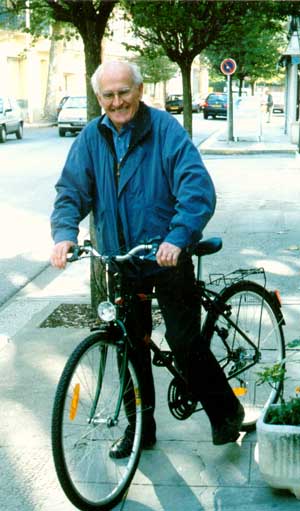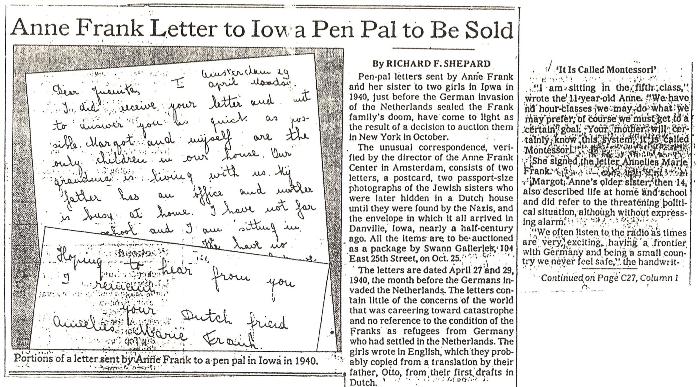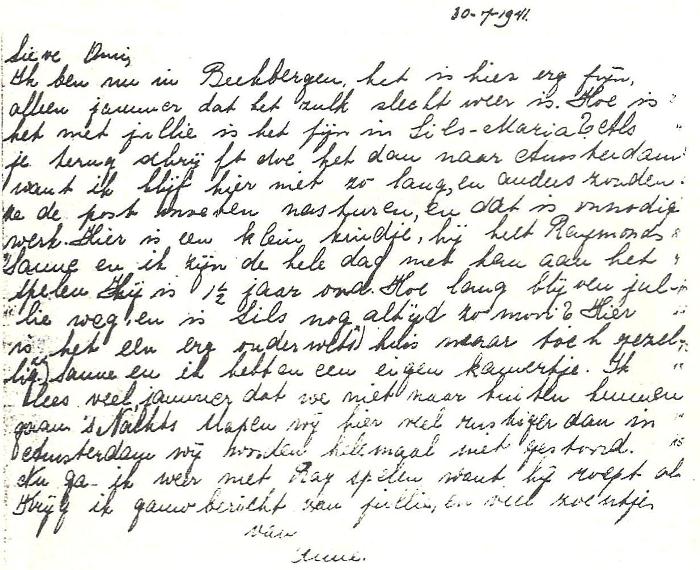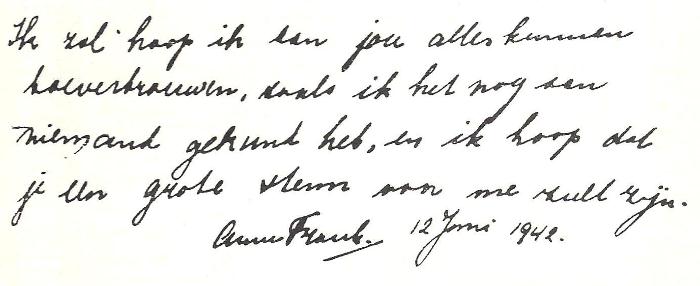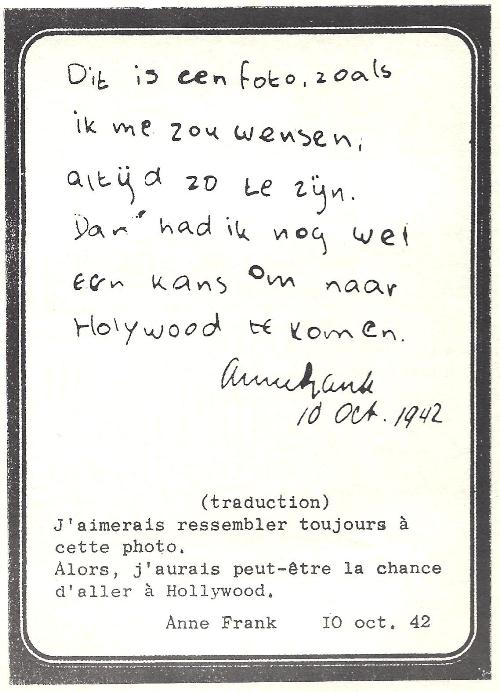The Diary of Anne Frank: Is it Genuine?
An Update
This article, written in June 2000 at the request of Italian scholar Cesare Saletta, is adapted from the preface to the recently-published Italian edition of Dr. Faurisson’s essay, “Is the Diary of Anne Frank Genuine?,” which was originally written in 1978 for submission to a Hamburg court, and published in French, two years later, in a work by Serge Thion.[1] In the following essay, the author takes another look at the famous diary (or diaries), taking into account developments since then, including the publication in 1986 by a Netherlands government agency of a comprehensive “critical edition” of the Anne Frank diary.
– The Editor
Robert Faurisson is Europe's foremost Holocaust revisionist scholar. Born in 1929, he was educated at the Paris Sorbonne, and served as a professor at the University of Lyon in France from 1974 until 1990. He was a specialist of text and document analysis. After years of private research and study, Dr. Faurisson first made public his skeptical views about the Holocaust extermination story in articles published in 1978 and 1979 in the French daily Le Monde. His writings on the Holocaust issue have appeared in several books and numerous scholarly articles, many of which have been published in this Journal. A four-volume collection of many of his revisionist writings, Ecrits Revisionnistes (1974-1998), was published in 1999. This essay is adapted from a piece written in June 2000 as the preface to a recent Italian edition of “Is the Diary of Anne Frank Genuine?”
Pierre Vidal-Naquet in 1980: ‘A Doctored Text’
In 1980, the prominent French Jewish scholar Pierre Vidal-Naquet, in whose eyes I am nothing but an “assassin of memory” (Jewish memory, it is understood), nonetheless wrote:[2]
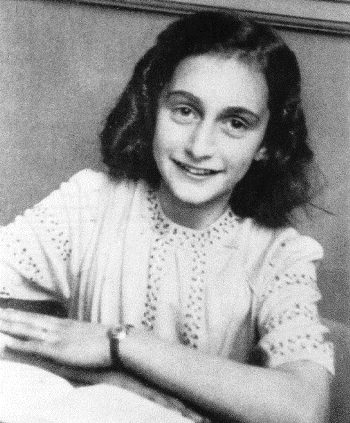
Anne Frank in 1942. She died of typhus in the Bergen-Belsen concentration camp in March 1945, shortly before her 16th birthday. On March 16, 1945, a revisionist researcher has found, 102 women, girls and babies named “Anne” or “Anna” were killed in the Bavarian city of Würzburg, victims of an incendiary bomb attack by Allied war planes.
It sometimes happens that Faurisson is right. I have said publicly, and repeat here, that when he shows that the Anne Frank diary is a doctored text, he may not be right in all details, [but] he is certainly right overall and an expert examination made for the Hamburg court has just shown that, in effect, this text was at the very least revised after the war, since [it was written] using ballpoint pens which appeared only in 1951. That is plain, clear and precise.
Those familiar with Vidal-Naquet, and his penchant for chopping and changing, will not be surprised to learn that, a few years afterwards, the professor repudiated this statement.
The 1986 ‘Critical Edition’ of the Anne Frank Diary
In 1986 there appeared in Amsterdam, under the direction of the Netherlands State Institute for War Documentation – Rijksinstituut voor Oorlogsdocumentatie (RIOD) – a big volume with “scholarly” pretensions.[3] (The dust jacket of the US edition calls this “the most fascinating, comprehensive study of that diary in existence,” while the dust jacket blurb of the French edition similarly calls this the “complete edition of the diary’s three versions.”) Those words communicated, not that Anne Frank’s “diary” was genuine, but rather – and what a surprise, this plural! – that her “diaries” were. With much circumspect wording, this book accused the young girl’s father, Otto Heinrich Frank, of having carried out manipulations of the original texts, and of having lied. Of the abusive “corrections” and “cuts” imputed to the latter, the Netherlands Institute stated straightforwardly:[4]
All this may seem natural and understandable in one who aspired merely to publish the essence (“das Wesentliche”) of the literary bequest, the document humain, of his daughter, in what appeared to him a fit and proper manner. However, the sentence inserted on his authority at the conclusion of the Dutch edition of the Diary: “With the exception of a few sections of little interest to the reader, the original text has been retained,” must be seen as something more than an obvious understatement.
Otto Frank stuck to this conviction to his death: “the essence” had been published and that was the end of the matter. No amount of argument could make him change his mind.
As a result, over the long years during which the diary went on to play an increasingly important role in the view of millions of people who came to look on it as a historical document rather that as a work of literature, he did not make it easier to ward off attacks on the book.
The Netherlands Institute thus conceded to me a point of capital importance: I had been right in reproaching Otto Frank and in attacking his stubbornness in hiding the truth about his manipulations. But the “critical edition” held that there had nevertheless existed a whole series of Anne Frank diaries, all genuine, and that thus I had been wrong on the other, essential question, of the diary’s authenticity. I had, therefore, the right to expect both a rebuttal of my arguments on that point, and a demonstration of the authenticity of the diaries. Yet, in this purportedly scholarly Netherlands Institute edition, I found nothing of the kind.
A Diversionary Tactic
This 720-page work resembles the sort of deception whereby an attempt is made, through a show of learning on a given subject, to draw attention away from the matter at hand. In this case, the demonstration is essentially nothing more than a handwriting analysis. Accompanied with a generous array of photographs and tables, stress is laid in this “scholarly” book on the similarities between handwriting samples, while differences – glaring even to a layman – are handled with great discretion.
A crucial point: We are not shown the two handwriting samples that I had reproduced in my analysis (page 297 of Thion’s 1980 book), and no analysis of them is offered by the Netherlands Institute. I refer here to two extraordinarily divergent samples: the “adult” cursive script dated June 12, 1942, and the “childish” printed script dated four months later, October 10, 1942; the two “Anne Frank” signatures alone differ peculiarly. It was in this regard that I most wanted an answer, for this goes to the heart of the matter.[5]
There is no sample of Isa Cauvern’s handwriting, about whose involvement I had voiced suspicions. She had been Otto Frank’s secretary. She married Albert Cauvern, a dramatist working for a Dutch radio station. Isa and Albert Cauvern worked on the “diary” manuscript and on the various typescripts. In 1947, the year that the first edition of the “diary” was p ublished in the Netherlands under the title Het Achterhuis, she committed suicide, a fact that the Netherlands Institute’s “critical edition” does not mention.[6]
A Comparison of Handwriting Samples, Each Attributed to Anne Frank
April 29, 1940, from a letter written when Anne was nearly eleven years old. Source: “The New York Times,” July 22, 1988, front page. (Click to enlarge)
July 30, 1941. Source: “The Diary of Anne Frank: The Critical Edition” (New York: Doubleday, 1989), p. 107. (Click to enlarge)
June 12, 1942, when Anne was exactly 13 years old. Source: “The Diary ofa Young Girl: The Definitive Edition” (New York: Doubleday, 1995), p. ix. (Click to enlarge)
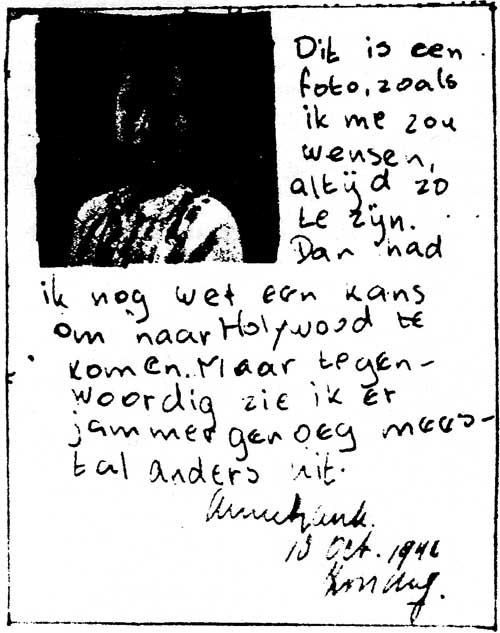
October 10, 1942. The text reads: “This is a photograph of me as I wish I looked all the time. Then I might still have a chance of getting to Hollywood. But at present, I'm afraid, I usually look quite different. Anne Frank. 10 Oct. 1942 Sunday” Source: “The Diary of Anne Frank: The Critical Edition” (New York: Doubleday, 1989), p. 282. (Click to enlarge)
October 10, 1942. The original text has apparently been both altered and cut. Source: Richard Amdur, “Anne Frank” (New York: Chelsea House, 1992/1993), p. 61. (Click to enlarge)
Nor is there any analysis, or even a sample, of the manuscript of the short stories attributed to Anne Frank, published as “Tales from the Secret Annex.” I had been struck by the appearance of this manuscript: the “Tales” handwriting resembles that of a meticulous elderly accountant. Why, of all the manuscripts attributed to the girl, had this one not been made available to the experts?
Above all, however, the authors of this “scholarly” edition, by insisting so much on the study of handwritings, have abdicated what ought to have been their main task: the examination of the content. They should have made it their first task to provide the reader with evidence that, contrary to what I had written, the “diary” account actually does mirror a physical or material reality. Moreover, they should have shown that this account, in all the forms of it that we know, is coherent and comprehensible – which is far from the case. But there is no such demonstration. At the beginning of this detailed work, there is indeed an attempt to grapple with the physical or material impossibilities I had pointed out, but this attempt comes to a sudden end. A response is made to a single point: that of the noises, at times quite loud, made by eight persons over a period of more than two years in a small space, presumed to be uninhabited; noises even at night, while “the enemies” are absent, the slightest noise must be avoided and, if someone has a cough, he or she takes codeine. Yet, in the attic, in the middle of the day, Peter cuts wood in front of an open window! My argument on this point is derided: my adversaries dare to respond, in the face of conclusive textual proof to the contrary, that “the enemies” were not there, at this or that precise moment, to hear anything.[7] All of my other arguments are passed over in silence. For his part, Otto Frank, during my meeting with him in 1977, after I had put him in an awkward position with my utterly down-to-earth questions, found no better reply than:
Mr. Faurisson, you are theoretically and scientifically right. I agree with you one hundred percent … What you point out to me was, in fact, impossible. But, in practice, it was nevertheless in that way that things happened.
To which I answered that, if he would be so good as to agree with me that a door could not be both open and shut at the same time, it followed that he, in practice, could not have seen a door in such a state. Yet, if I may put it thus, such physical or material impossibilities as simultaneously open and shut doors were already legion in the Anne Frank diary as we knew it at the time. What can one say of the likely growth in number of those impossibilities in the “diaries” (plural)?
A Financial Swindler?
Here is nonetheless a part of this “scholarly” edition that I cannot recommend enough to readers. It is that in which the rather unsettling prewar past of Otto Frank and his brother Herbert is revealed. In a preventive step against a possible revisionist inquiry into the matter, the authors inform us that in 1923 Otto Frank founded, in Frankfurt, a bank called “M. Frank and Sons.” The three men who headed this firm were Herbert and Otto Frank and – this detail is of some importance for the story of the Anne Frank diary – one Johannes Kleiman, a man who appears in the diary under the name of Jo Koophuis and who, after the war, was to act as an informer against “collaborators” for the Dutch “Political Criminal Investigation Department.”[8] Even before Hitler came to power in January 1933, the bank was implicated in various shady dealings. A trial was held, but Herbert, the principal, chose not to appear. He fled the country, finding refuge in France. As for Otto Frank, the Netherlands Institute authors do not tell us anything clear about what happened to him. They go only so far as to inform us that the relevant court records are missing, and that this is “in any case regrettable,”[9] an observation which lends a somewhat dubious aspect to the documents’ disappearance. In any event, Otto Frank may have fled to the Netherlands in 1933 to evade German justice.
Before engaging in a kind of literary swindle, had Frank been involved in financial swindling? During the war, thanks to various subterfuges and to the support of his three main partners (all “Aryans”), he had the satisfaction of seeing his two firms make money in their dealings with, among other concerns, a Dutch mainstay of the Dresdner Bank, one of Germany’s largest banking firms. It can be stated that, even during his time in hospital at Auschwitz, his Amsterdam business carried on under the supervision of his associate Jan Gies. Back in Amsterdam after the war, he had a brush with the Dutch legal authorities, who were very attentive to matters of economic collaboration with Germany during the occupation. But an arrangement, we are told, was found.[10]
Worthless Evidence and Doubtful Witnesses?
The authors of this Netherlands Institute “critical edition” deal severely with the evidence and witnesses advanced by Otto Frank.
To begin with, they consider that the three expert analyses on which Frank based his claim of the diary’s authenticity are devoid of any value.[11] Let us recall that those analyses, the absurdity of which I had pointed out, nevertheless received, in the 1960s, the endorsement of German judges, who used them in convicting those who, before me, had cast doubt on the diary’s alleged authenticity.
Similarly severe is the appraisal of the Netherlands Institute of Ernst Schnabel’s book Spur eines Kindes (published in the United States under the title Anne Frank: A Portrait in Courage), which Otto Frank had enthusiastically advised me to read, and which also served to defend his argument. According to the Institute’s “critical edition” authors: “Since it [Schnabel’s book] contains various errors, all quotations from it should be treated with reservation.”[12] As for Frank’s star witness, the all-too-famous Miep Gies, it is an understatement to say that, on certain vital points of her testimony, she inspires no great confidence at the Netherlands Institute. The same goes for Victor Kugler (“Victor Kraler”).[13]
The Netherlands Institute ‘Critical Edition’ Fiasco
All things considered, the Netherlands Institute’s “critical edition” of the Anne Frank diary is a disaster for the late Otto Frank and for his experts, friends, and those who have vouched for him. Clearly, Frank’s cause has been deemed indefensible. But, by cutting away the deadwood in an attempt to preserve the tree, that is, by sacrificing Frank’s reputation in order to save that of his daughter’s alleged diary, the pruners at the Netherlands State Institute have found themselves confronting a kind of nothingness. Only a questionable “handwriting analysis” emerges from it all, which is all the more laughable given that, a few years after the publication of their “critical edition” in 1986, other samples of the girl’s writing in various personal letters and postcards appeared on the open market. These samples, which seem genuine to me, have rendered worthless the Netherlands Institute’s laborious analyses. In any case, the experts’ work must now be reviewed from beginning to end.
Finally, I shall add that this big book contains no plan of the house in which, for more than two years, the eight persons allegedly lived in hiding.[14] Previous editions of the diary did carry such a plan, on which I have commented and which I compared with the house as I found it. This examination provided an argumentation with which to prove the fictitious nature of the whole account. The authors of the “scholarly” edition chose not to include a plan of the house. This is both an admission and an evasion.
In short, behind its show of erudition, this “comprehensive” Netherlands Institute edition is a fiasco.
The 1991 ‘Definitive’ Edition
In the wake of the publication of the Netherlands Institute’s study, it was only fitting to issue, for the general readership, a new “standard” edition of the diary to replace the one that Otto Frank had brought out in 1947. There was a real need to repair the damage wrought by the father, damage denounced by the Netherlands Institute. A certain Mirjam Pressler was entrusted with the job and, in 1991, there appeared a revised (herziene) and enlarged (vermeerderde) Dutch-language edition, which was presented as conforming fundamentally with what Anne Frank had written. This edition was described as “definitive.” In 1995 there appeared an English translation – similarly presented as “definitive.”[15]
An anomalous note, if not deceptive advertising, appeared on the title page, where the editor had the audacity to write: “The definitive edition… established by Otto H. Frank and Mirjam Pressler.” Dead since 1980, Frank could hardly have collaborated with Pressler on this 1991 work – one that, moreover, is for him a posthumous snub. I venture to say that never has a French paperback book been so laden with confused explanations on its title page and introductory page, in its foreword, in the pages of the “note on the present edition” and, finally, in its afterword. One is barely able to make head or tail of it all. The editor’s unease is obvious. Clearly he did not know just how to convey to the reader that this new Anne Frank diary is – this time for sure, and once and for all – the genuine diary.
We are told that Mirjam Pressler is “a popular, prize-winning writer of books for young readers and a well-known translator,” and that she lives in Germany. But we are not told what method she might have employed to establish this text, based on the three texts of the “critical edition.” How did she make her choices? What was her reason for keeping one fragment and discarding another? These questions remain unanswered.
I am not alone in noticing these irregularities. Even among aficionados of the legendary figure of Anne Frank, this odd Pressler edition is sometimes criticized, and in forceful terms. Writing in the British monthly Prospect, Nicolas Walter devotes three columns to the English edition. His article bears a title with a double meaning: “Not completely Frank.”[16] He observes that the amalgamation of the three versions (the old translation and the two new ones) leaves us “with the result that all sorts of distortions and discrepancies remain.” He adds: “The English version is said to be ‘basically… as she wrote it,’ which is not true, and it is described as the ‘definitive edition,’ which is nonsense.” Walter goes on to write that this “standard” version is indeed “about one third longer” than the old “standard” version, but notes:
…it is still an eclectic conflation of A and B [that is, the first two versions of the “critical edition”], and it is marred by errors and omissions; many passages are in the wrong places and several passages are missing.
Walter concludes by asking whether Anne Frank’s memory “should not … be properly served by a satisfactory reading edition of her diary after half a century.”
The Afterword by Rosselin-Bobulesco
The 1992 French edition of this new “standard” version includes an afterword by Isabelle Rosselin-Bobulesco that, unhappily, is absent from the English-language edition. The author defends, of course, the argument according to which the “scholarly” edition settled the controversy about the authenticity of Anne Frank’s diary – a claim that, as can be seen, amounts to wishful thinking. Still, I recommend reading the section devoted to “The authenticity of the Diary” and, in particular, pages 348-349, where my own position is outlined almost forthrightly, and where reasons for doubting that authenticity, which were inspired by Otto Frank’s behavior, are mentioned. I regret only that, at least in the passage that I will quote here, these reasons are presented as if it were a matter of obvious things on which everyone agreed. In reality it was, for the most part, my 1978 analysis that brought to light all that follows in the passage, and which evoked, at the time, all of the attacks on me – attacks that, as can be seen today, were in fact slanders.
Here I yield the floor to Rosselin-Bobulesco, highlighting some of her words:
At his death, Otto Frank bequeathed all of Anne’s writings to the Netherlands State Institute of War Documentation, the RIOD. In the face of the assaults calling the authenticity of the diary into question, the RIOD considered that, in view of the Diary’s quasi-symbolic aspect and historical interest, it had become indispensable to allay the doubts. We know that inaccuracies were not lacking. The diary was written in several notebooks and on loose-leaf. Anne Frank herself had drafted two versions. There had been several typed versions that did not entirely follow the original text. Modifications, additions, or removals had been effected by her father. Besides, corrections had been introduced by persons whom Otto Frank had asked to reread the diary, lest his own insufficient knowledge of Dutch prevent a proper weeding out of his daughter’s mistakes in spelling and grammar. Furthermore, the Dutch editor himself had also modified the text by removing certain passages of a sexual character, deemed at the time to be too shocking, those in which Anne speaks of her menstrual periods, for example. As for the different translations, they evinced disparities. There were inaccuracies in the German translation, certain passages had been suppressed so as not to offend the German reader. The translation had been made from a typewritten text that was not the definitive text that had served as the basis for [the original book in Dutch]. In the American edition, certain passages that had been removed from the Dutch version had, on the contrary, been reinserted. Several expert analyses of the handwritten text were carried out, several lawsuits had been filed, in response to the attacks against the diary. Never had there emerged a clear picture of the situation, even if the outcome of the court cases and of the inquiries upheld Otto Frank.
Isabelle Rosselin-Bobulesco may minimize the actual facts as she wishes, and she may present things in the colors of her choice: all the same, this passage makes clear that I was perfectly well founded in believing neither the text of the alleged Anne Frank diary nor the replies to my questions by Otto Frank.
The December 1998 Amsterdam Judgment Against Me
Nevertheless, on December 9, 1998, a court in Amsterdam found a way to rule against me for my analysis of the diary of Anne Frank. This study, which I drafted 20 years earlier for a German court, had been published since 1980 in France and in a number of other countries without ever prompting legal action. In the Netherlands, however, it will not do to lay an impious hand on the icon of Saint Anne Frank.
The intrepid Siegfried Verbeke had translated my 1978 study into Dutch-Flemish, publishing it in a 1991 brochure entitled “The ‘Diary’ of Anne Frank: A Critical Approach” (Het ‘Dagboek’ van Anne Frank: een kritische benadering).[17] Verbeke introduced my text with a foreword that was certainly revisionist in character but altogether moderate in tone. Two associations then filed a lawsuit against us: the Anne Frank Foundation in Amsterdam, and the Anne Frank Fund in Basel. These organizations are known for the ruthless war they wage against each other over the corpse of Anne Frank and the remains of her late father, but in this case, faced with danger to their identical financial interests, they decided to make common cause. It must be said that an enormous business has grown up around Anne Frank’s name, a veritable “industry,” as Nicolas Walter calls it.
The plaintiffs claimed, in particular, that my analysis gave “negative publicity” to their associations, with unpleasant financial results. For example, the Anne Frank Foundation, which runs the Anne Frank House in Amsterdam as a popular tourist center, revealed that it had to spend time and money combatting the booklet’s harmful effect. Indeed, my own information leads me to believe that the personnel of the Anne Frank House receive special training enabling them to respond effectively to queries or arguments from visitors who have been influenced by reading Verbeke or Faurisson. The Foundation added:
Moreover, the statements in the booklet may in the long term cause the number of visitors to Anne Frank House to diminish, with Anne Frank House’s management finding itself in difficulties as a result.
In its decision, the court did not fail to adopt, as its own, the plaintiffs’ views on “the symbolic function that Anne Frank has acquired,” and on the decidedly perverse nature of the revisionists Verbeke and Faurisson. Relying solely on the handwriting analysis requested by the Netherlands State Institute, the Amsterdam court declared that it was impossible to call into question the authenticity of the work attributed to Anne Frank. The court added:
Toward the victims of the Holocaust and their surviving relatives, the remarks [of Verbeke and Faurisson] are hurtful and needlessly offensive. It follows inescapably that they cause [the survivors] psychological or emotional injury.
Copyright Infringement?!
The most staggering part of the ruling was the court’s finding that I had personally breached the law on copyright by quoting numerous extracts from the Anne Frank diary. The court ruled, without citing evidence, that “the quotations [on pages 36-39 of the booklet] are removed from their context in an unwarranted manner.” This referred to the beginning of my analysis, that is, the parts I had numbered from four to ten, in which, with a salvo of very brief quotations, I listed the manifold physical or material impossibilities in the “diary.” Quite obviously, neither Otto Frank nor anyone else has ever found a reply to this. But that court in Amsterdam found, if not an answer, then at least a way out: in the court’s view, my quotations are simply not to be considered because, apparently, they infringe copyright.
In my long experience with law courts, in France and abroad, I have had occasion to witness a good deal of baseness, of sophistry, of warping and twisting the truth, as well as every sort of judicial ploy. Nonetheless, I believe that this Amsterdam court, in its decision of December 9, 1998, overstepped the bounds of decency in rebuking me for having, in a textual analysis, repeatedly quoted from the text. Not one of those quotations, incidentally, had been removed from its context. On the contrary, with painstaking diligence, I had, I believe, demonstrated great care in looking over, as closely as possible, all the words of the text proper, then putting those same words back into their most direct context. But it is likely that the court understood the word “context” in a broad and flexible sense, as too often happens, that is, of a context that is historical, sociological, psychological, and so forth. In doing so, the court, of course, gave its own subjective view of the history or psychology of an Anne Frank whom it conceived in line with its own imagination, without paying the slightest heed to the words that, one by one, constitute a work called the diary of Anne Frank.
A Judgment With the Help of the French Police and Justice System
Verbeke and I were ordered to pay heavy court costs, and the sale of our book was banned in the Netherlands on pain of a fine of 25,000 Dutch guilders per day per copy displayed in public.
Let us add, for the record, that the plaintiffs had the long arm of the law on their side. From Amsterdam, they had gotten the French police to call on me at home in Vichy, had me summoned to the station for questioning, and had bailiffs drop by bearing court orders and formal demands. The French justice ministry’s Service civil de l’entraide judiciaire internationale, with the French taxpayer footing the bill, worked very well in tandem with the Dutch police.
A Field of Research for Computer Specialists
In 1978 I was not able to take advantage of the opportunities offered by the computer. With pen in hand, I sedulously studied the Anne Frank diary, searching for certain words that, at times, were far removed from one another, “cutting and pasting” them with scissors and glue, and counting them on my fingers. As a result, there occurred errors of detail on my part that I have sometimes managed to correct. I am aware of the imperfection of the final result as it stands today. It is my hope that, in the future, researchers who are adept with computers will take up my analysis and revise it on those points.
The four editions of the Netherlands Institute (RIOD) diary – one each in Dutch, German, French and English – open up a superb field of research for such people. Working from the old versions in Dutch, German (two German versions!) and French, I was able to demonstrate the existence, as it were, of different Anne Franks, irreconcilable with one another, as well as the existence of contradictory accounts. Today, with the more recent versions from the Netherlands Institute and Mirjam Pressler, persons skilled in the use of computers should find it possible to take apart, bit by bit – and better than I had done – this literary forgery.
For the same can be said of the “diary” of Anne Frank as of any imposture: the more someone strives to defend it, the more he provides, in spite of himself, arguments that discredit it. In other words, by shielding a lie, one becomes ensnared in one’s own lies. To take but one example dear to revisionists, the fallacious character of Kurt Gerstein’s so-called testimony is exposed just as well by analyzing a single version of it as by comparing it with other, contradictory versions.
But let us be practical: to begin at the beginning of this new job of analyzing the Anne Frank “diary,” I suggest that a team of researchers with good computer skills, all possessing a good knowledge of Dutch and German, undertake a comparative study of the following:
- In Dutch, first the 1947 version (published by Otto Frank under the title Het Achterhuis), then the 1986 Netherlands Institute (RIOD) versions, and finally, Mirjam Pressler’s 1991 edition.
- The corresponding German versions, it being understood that, as I discovered in 1978, there appeared, after the version published in 1950 by Lambert Schneider, a slightly different one in 1955, published by Fischer Verlag.
At a later stage, it will still be permissible to carry out an analysis of the different French and English versions and then, to settle the matter for good, there can be a comparison of the ten or so Anne Franks who emerge from all the Dutch versions and various translations.
Only then, and regardless of what the profiteers who have exploited her memory for so long may have to say about it, will justice finally be done to the one, the genuine Anne Frank, who never wrote this “cock-and-bull story,” first published in Dutch in 1947 and then published (in its US editions), in 1953 as The Diary of a Young Girl, re-christened, in 1986-1989, after renovation and makeshift repairs, The Diary of Anne Frank: The Critical Edition, before ending up being called, in 1995 (for English readers), after much patching and façade work, The Diary of a Young Girl: The Definitive Edition, by “Anne Frank.”
Post scriptum
On pages 94-96 of the US edition of the Netherlands Institute’s “Critical Edition,” David Barnouw proclaims that he has summarized what he is willing to call my analysis, but not without insinuating that I am a trickster.
Of all my material or physical arguments, he responds to only one, that of the loud noises made by those hiding in the “Annex.” Then, of all the instances of noises I cite, he deals with only three. He claims that, in these three cases, I concealed the fact that Anne Frank specified that, because the “enemies” were not nearby, there was no risk of the noises being heard. My reply is that perhaps the nearby “enemies” (for example, the two shop assistants) weren’t there, but that the other “enemies,” indefinite in number, could have heard those noises: that of the vacuum cleaner, every day at 12:30 p.m., as well as the “endless peals of laughter” or “a doomsday racket.” Barnouw is much distressed at having to explain these noises and others, sometimes dreadfully loud, in a dwelling where the stillness of the grave should have prevailed. Additionally, he resorts to ruminations as diffuse as they are murky, to spare himself effort as well as to mislead. He writes:[18]
From the diary it appears that the inhabitants of the Annexe, too, had to brave many dangers, not least the chance that they might make too much noise and be overheard. Faurisson, however, did not examine the overall picture of life in hiding in any depth, or concern himself greatly in this context with the fact that the Frank family and their fellow fugitives were in the end arrested.
Here Barnouw evinces a pathos that allows him to conclude shamelessly: “Given the above extract [of Faurisson’s analysis of the question of noise], we have no need to subject all the examples mentioned by Faurisson to review.” In my opinion, this last remark is proof that the Netherlands Institute authorities, by their own admission, have not wished to “submit to review” an essential part of my analysis, that which concerns the physical or material impossibilities of the account.
On another point Barnouw insinuates that I am dishonest. On page 261 of Serge Thion’s book, I had mentioned my discovery, during my investigation into the circumstances of the arrest of the eight fugitives in Amsterdam on August 4, 1944, of an especially interesting witness. I wrote:
This witness [in 1978] made us promise, myself and the person accompanying me, not to divulge her name. I gave her my word to keep it secret. I shall only half keep my promise. The importance of her testimony is such that it seems to me to be impossible to pass over it in silence. This witness’s name and address, together with the name and address of the person accompanying me, are recorded [on a paper] in a sealed envelope contained in my “Appendix no. 2: Confidential” [for submission to the court in Hamburg].
Barnouw begins by quoting these lines, but not without excising the sentence which revealed the reason for my discretion: the witness had made us promise – that was the word – not to name her. Then Barnouw adds deceitfully:
A photograph of this sealed envelope is printed as an appendix to Faurisson’s “investigation,” albeit only in the French version of 1980; the publisher of the Dutch version had the sense to leave out this piece of evidence.
In other words, Barnouw suggests, I had fooled my readers, leading them to believe, by means of this alleged trick, that the envelope in reality contained no names. Barnouw suggests that this envelope, if it ever even existed, was empty. The truth is that I had indeed submitted to the court in Hamburg an envelope containing the names and addresses of the two persons in question. Today, 22 years later, I believe myself justified in divulging these names, which have long been known to the court: Mrs. Karl Silberbauer and Mr. Ernst Wilmersdorf, both of whom lived in Vienna.
On this occasion I will also reveal the names of three French academics of whom it is stated, on page 299 of the Thion book, Vérité historique ou vérité politique?, that they concurred with my findings on the alleged diary of Anne Frank. The first is Michel Le Guern, a professor of literature who at the time was lecturing at the University of Lyon-2 and who has recently published, in the prestigious “Bibliothèque de la Pléiade” series, a scholarly edition of Blaise Pascal’s Pensées. It would be difficult to think of a more proficient authority on literary analysis.
The closing sentence of Le Guern’s written testimony of 1978 reads as follows:
It is certain that the conventions of literary exchange authorize Mr. Frank, or anyone else, to put together as many fictitious personae of Anne Frank as he may wish, but on condition that he not identify any of these fictional beings as the real Anne Frank.
Two other academics were about to come to a similar conclusion when suddenly, in November 1978, the “affaire Faurisson” exploded in the press. They are Frédéric Deloffre and Jacques Rougeot, both professors at the University of Paris IV-Sorbonne.
Today these three men are all retired. That is why I have decided to reveal their names. I had not, in any case, given them any pledge of confidentiality.
Notes
| [1] | Serge Thion, Vérité historique ou vérité politique? (Paris: La Vieille Taupe, 1980), pp. 213-300. This essay, “Is the Diary of Anne Frank Genuine?,” was published in English in the Summer 1982 Journal (vol. 3, no. 2), pp. 147-209. See also: R. Faurisson, “Anne Frank’s Handwriting,” Spring 1989 Journal (vol. 9, no. 1), pp. 97-101; M. Weber, “Anne Frank,” May-June 1995 Journal (vol. 15, no. 3), p. 31. In 1989, 1993 and 1995, respectively, I wrote three items dealing with a work that claimed to disprove my findings. These three items may be found in my Ecrits révisionnistes 1974-1998, a four-volume collection of my revisionist writings, privately published by me in 1999 for restricted distribution: pp. 856-859, 1551-1552, 1655-1656. |
| [2] | Interview in Regards, weekly of the Centre communautaire juif of Brussels, November 7, 1980, p. 11. Among his many publications, Pierre Vidal-Naquet is author of the anti-revisionist book Assassins of Memory: Essays on the Denial of the Holocaust, which is reviewed by M. Weber in the Nov.-Dec. 1993 Journal, pp. 36-39. |
| [3] | The Diary of Anne Frank: The Critical Edition (New York: Doubleday, 1989). David Barnouw and Gerrold van der Stroom, eds. “Prepared by the Netherlands State Institute for War Documentation.” |
| [4] | The Diary of Anne Frank: The Critical Edition (New York: 1989), cited above, p. 166 (“Afterword”). The German and French editions were published in 1988 and 1989 respectively. I have in my possession these four bulky volumes, that is, the Dutch original and the three translations. Comparisons between them reveal some odd differences. |
| [5] | These can be seen in The Journal of Historical Review, along with articles by Faurisson: Summer 1982 Journal, p. 209, and Spring 1989 Journal, pp. 99-100. |
| [6] | The Diary of Anne Frank: The Critical Edition (1989), cited above, pp. 63-64. |
| [7] | The Diary of Anne Frank: The Critical Edition (1989), cited above, pp. 95-96. |
| [8] | The Diary of Anne Frank: The Critical Edition (1989), cited above, pp. 30-31. This agency is not to be confused with the “Supervisory Board for Political Offenders,” mentioned on p. 34. |
| [9] | The Diary of Anne Frank: The Critical Edition (1989), cited above, p. 4. |
| [10] | The Diary of Anne Frank: The Critical Edition (1989), cited above, pp. 15, 55-56. |
| [11] | The Diary of Anne Frank: The Critical Edition (1989), cited above, pp. 88-90. |
| [12] | The Diary of Anne Frank: The Critical Edition (1989), cited above, p. 19, n. 41. |
| [13] | The Diary of Anne Frank: The Critical Edition (1989), cited above, pp. 36-45. |
| [14] | Of the various language editions of the “critical edition,” there is a partial plan of the “Annex” house only in the English-language edition. See: The Diary of Anne Frank: The Critical Edition (1989), cited above, p. 213. This plan is only for three floors, whereas the house actually had five (as I have shown in the photographs I published, for example, in S. Thion’s book, Vérité historique ou vérité politique?). |
| [15] | Anne Frank, The Diary of a Young Girl: The Definitive Edition (New York: Doubleday, 1995.) “Edited by Otto H. Frank and Mirjam Pressler.” Translated by Susan Massotty. |
| [16] | Prospect, August-September 1997, p. 75. Prospect is aimed at an intellectual and academic readership. |
| [17] | See “A Belgian Foundation Battles for Free Speech,” Jan.-Feb. 1996 Journal, p. 46. |
| [18] | This and the following quotes or citations in this “Post scriptum” section are from The Diary of Anne Frank: The Critical Edition (1989), cited above, pp. 94-96. |
“O what fine thought we had because we thought
That the worst rogues and rascals had died out.”
—W. B. Yeats, “Nineteen Hundred and Nineteen”
Bibliographic information about this document: The Journal of Historical Review, vol. 19, no. 6 (November/December 2000), pp. 2-11
Other contributors to this document:
Editor’s comments: n/a

